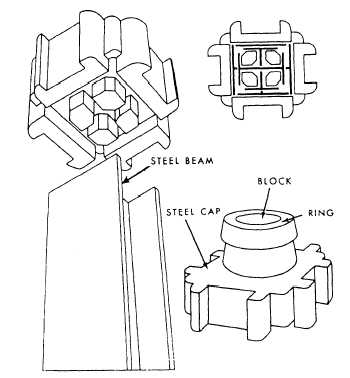caps. The buffer nut bumpers absorb the recoil of the
Belleville springs.
RAM-PISTON OVERSTRIKE.— The length of
free travel (maximum stroke) of the ram from the bottom
of the stroke to the safety catch lip at the top is 109 inches
(fig. 12-65). When the ram is recoiled high enough, the
ram rings will engage the safety catch lip and prevent it
from going out of the top. If the upward force of the ram
is too great, the whole hammer will be lifted off the pile,
possibly causing the rings to shear. To prevent this
danger, watch the projection of the ram above the
hammer and reset the throttle when necessary.
Pile-Driving Caps
A pile-driving cap is a block (usually a steel block)
that rests on the butt or head of the pile and protects it
against damage by receiving and transmitting the blows
of the hammer or ram. In the steam, or pneumatic,
hammer, the cap is a part of the hammer. The cap with
a drop or diesel hammer is a separate casting with the
lower part recessed to fit the head or butt of the pile and
the upper part recessed to contain a hard cushion block
that receives the blows of the hammer. The cap is fitted
with a wire rope sling so that the cap, as well as the
hammer, may be raised to the top of the leads when
positioning a pile in the leads.
On the DE-10 hammer, you place one cushion block
in the drive cap and lash the cap to the hammer front and
Figure 12-66.-H-beam pile-driving cap.
back with two pieces of 1/2-inch wire rope and clips.
You must allow 3 to 4 inches of slack in the wire rope.
The cap is normally lashed to the hammer after the
hammer is placed in the leads.
NOTE: The top of the cushion block should be kept
high enough to prevent the hammer shroud from fouling
on the rim of the drive cap pocket.
Pile-driving caps are available for driving timber,
concrete, sheet, and H-beam piles. Figure 12-66 shows
a pile cap designed for driving a H-beam pile.
Placing Hammer in Leads
Placing the pile-driving hammer in the leads is
performed two ways: while the leads are horizontal or
vertical.
Leads are not always used in pile-driving
operations. Pile hammers can be used as a flying
hammer, using special adapter caps attached to the
hammer (fig. 12-67). This is far the most dangerous of
all types of pile-driving operations and should be
attempted only by experienced personnel.
Figure 12-67.—Pile driving using a flying hammer.
12-47



